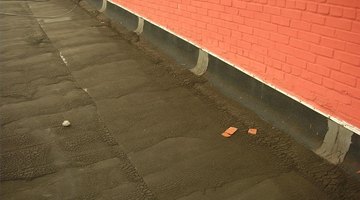How to Remove Asphalt Sealer From Bricks
Asphalt sealers work wonders for extending the life of any asphalt surface. Unfortunately, application can be messy and often leads to sealer ending up on neighboring brick surfaces.

Although it is true that the sealer will wear away over time, there is a straightforward removal process for both oil- and non-oil-based asphalt sealers.
-
Mix a cleaner such as Simple Green with a full bucket of water. Place a drop cloth over the asphalt surface that runs alongside the bricks.
-
Wet down and scrub the bricks with a scrub brush and the cleaning mixture. Allow the cleaning mixture a few minutes to settle on the asphalt sealer.
-
Rinse the bricks using a power washer. Set the psi (pounds per square inch) to 800 or less by rotating the dial in a clockwise direction. Too much water pressure will damage the brick. Repeat the cleaning and rinsing process as many times as needed to remove the asphalt sealer.
-
Pour a solvent cleaner such as Solvall directly onto the oil-based asphalt sealer. It is important to wear safety glasses and gloves during this project. The asphalt sealer can damage the skin and eyes.
-
Scrub the area briskly with a scrub brush. Let the solvent cleaner soak on the sealant for several minutes.
-
Turn the power washer on and set the pressure control dial to 800 psi by twisting it in a clockwise direction. Rinse away the asphalt sealer and solvent cleaner. The solvent cleaner will emulsify and render the oil-based sealant harmless to the environment.
Things You Will Need
- Gloves
- Safety glasses
- Bucket
- Scrub brush
- Simple Green type cleaner
- Drop cloth
- Power washer
- Solvall type solvent cleaner
Tip
Clean the brick surface as soon as possible for best results. If allowed to dry, the asphalt sealer removal will require more elbow grease. Askthebuilder.com gives overall comparisons for the different types of asphalt sealer and what it might take to remove them (see Resources).
Warning
Wear safety glasses and gloves to protect your eyes and hands. Keep cleaner away from sealant-covered asphalt. It will ruin the sealant coat.
Photo Credits
- jrobinson0123/Photobucket.com
- jrobinson0123/Photobucket.com
More Articles



